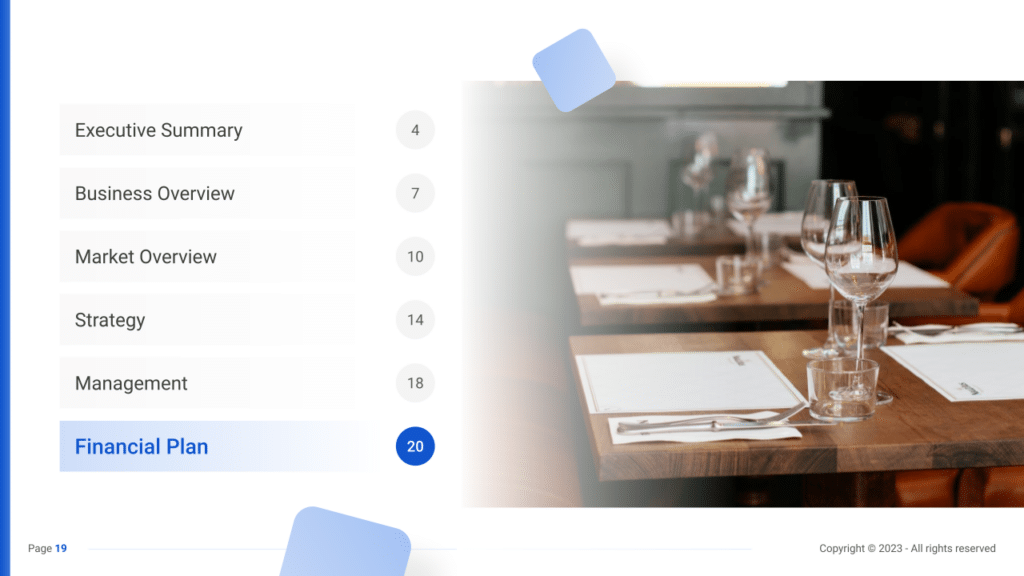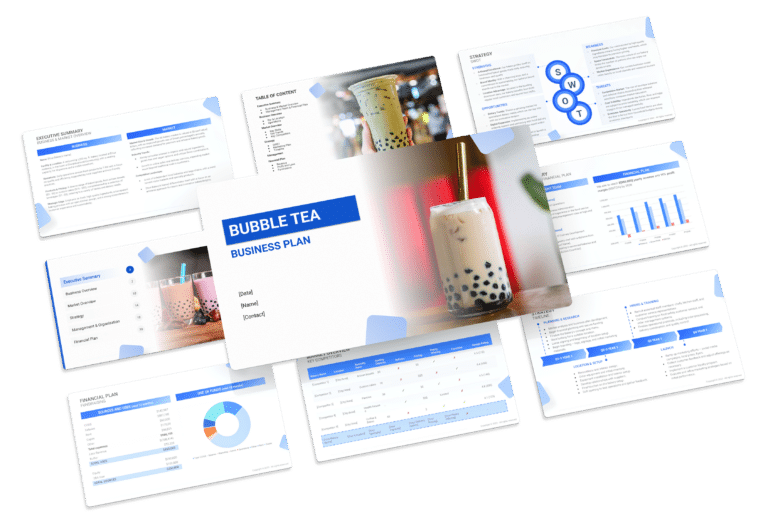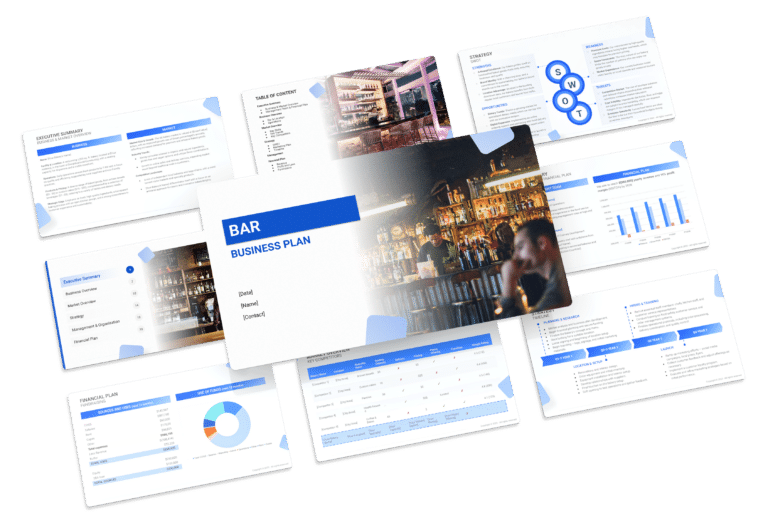Restaurant Business Plan Template & PDF Example

Creating a comprehensive business plan is crucial for launching and running a successful restaurant. This plan serves as your roadmap, detailing your vision, operational strategies, and financial plan. It helps establish your restaurant’s identity, navigate the competitive market, and secure funding for growth.
This article not only breaks down the critical components of a restaurant business plan, but also provides an example of a business plan to help you craft your own.
Whether you’re an experienced entrepreneur or new to the food and beverage industry, this guide, complete with a business plan example, lays the groundwork for turning your restaurant concept into reality. Let’s dive in!
The Plan
Our restaurant business plan is structured to cover all essential aspects needed for a comprehensive strategy. It outlines the restaurant’s operations, marketing strategy, market environment, competitors, management team, and financial forecasts.
- Executive Summary: Offers an overview of the restaurant’s business concept, market analysis, management, and financial strategy.
- Business Overview: Provides detailed information on the restaurant and its operational model:
- Restaurant & Location: Describes the restaurant’s prime location, size, seating capacity, and distinctive design, emphasizing its appeal to the target demographic.
- Supply & Operations: Outlines the supply chain management, focusing on local sourcing and quality ingredients, and details the operational aspects, including kitchen layout, equipment, and front-of-house operations.
- Market Overview: Examines the full-service restaurant industry landscape, identifying competitors and how the restaurant stands out:
- Key Stats: Shares industry size, growth trends, and relevant statistics for the full-service restaurant market.
- Key Trends: Highlights recent trends affecting the restaurant sector, such as health-conscious dining, sustainability, and technology integration.
- Key Competitors: Analyzes the main competitors in the vicinity, showcasing the restaurant’s unique selling proposition in comparison.
- Strategy: Outlines how the restaurant intends to achieve growth and attract patrons:
- SWOT: Strengths, weaknesses, opportunities, and threats analysis.
- Marketing Plan: Strategies for promoting the restaurant to maximize visibility and customer engagement.
- Timeline: Key milestones and objectives from the initial setup through the launch and operational optimization.
- Management: Information on who manages the restaurant and their roles.
- Financial Plan: Projects the restaurant’s financial performance, including revenue, profits, and expected expenses, aiming for profitability and sustainable growth.

Executive Summary
The Executive Summary introduces your restaurant’s business plan, offering a concise overview of your establishment and its offerings. It should detail your market positioning, the variety of cuisines and dining experiences you offer, its location, size, and an outline of day-to-day operations.
This section should also explore how your restaurant will integrate into the local market, including the number of direct competitors within the area, identifying who they are, along with your restaurant’s unique selling points that differentiate it from these competitors.
Furthermore, you should include information about the management and co-founding team, detailing their roles and contributions to the restaurant’s success. Additionally, a summary of your financial projections, including revenue and profits over the next five years, should be presented here to provide a clear picture of your restaurant’s financial plan.
Restaurant Business Plan Executive Summary Example
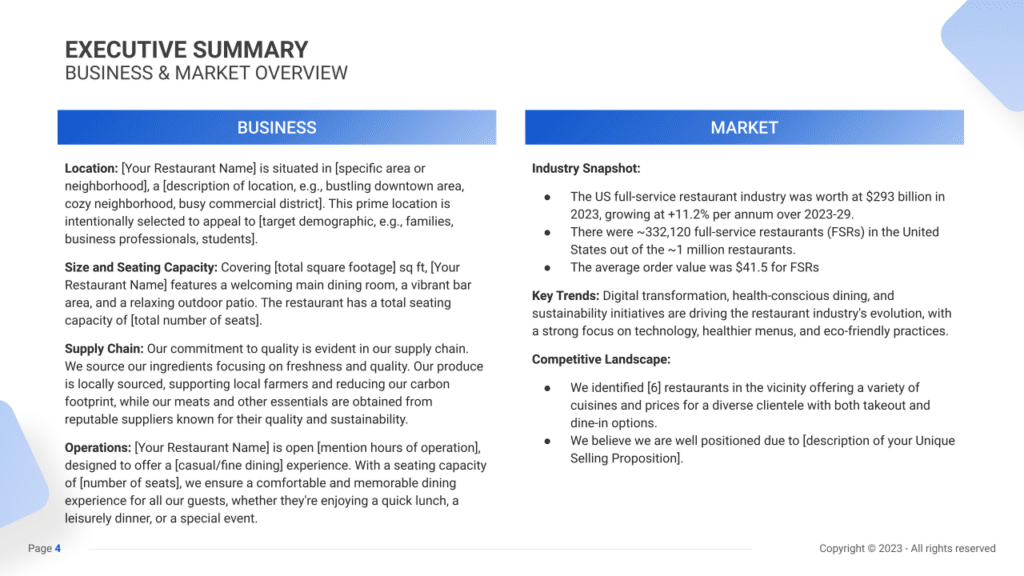
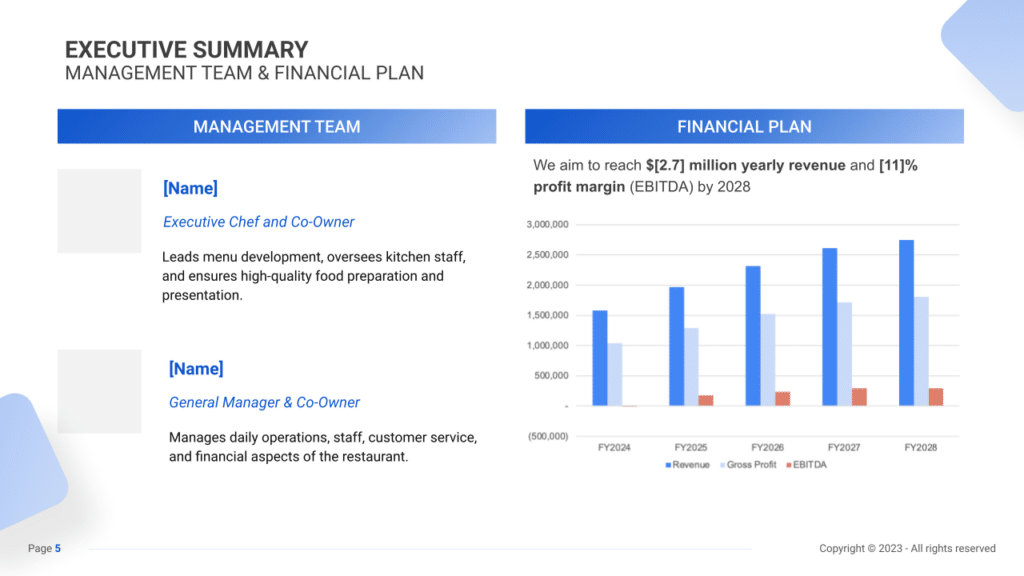
Business Overview
The business overview should detail the restaurant’s specific features, such as its seating capacity, ambiance, and supply chain practices. It’s important to emphasize how the restaurant caters to its target demographic through its strategic location and operational model.
Example:
“[Your Restaurant Name],” located in [specific area or neighborhood], covers [total square footage] sq ft and includes a main dining area, bar, and outdoor patio, offering a total of [number of seats] seats. The restaurant’s commitment to quality is reflected in its locally sourced produce and sustainable supply chain practices, catering to a diverse clientele.
Market Overview
This section involves analyzing the size, growth, and trends of the full-service restaurant market. It should address the industry’s digital transformation, health-conscious dining preferences, and eco-friendly practices, positioning the restaurant within the broader market context.
Example:
“[Your Restaurant Name]” enters a U.S. full-service restaurant market valued at $293 billion. The restaurant’s focus on technology, healthier menu options, and sustainability aligns well with current market trends and consumer preferences, setting it apart from six main competitors in the area.
Management Team
Detailing the management team’s background and expertise is crucial. This section should highlight how their experience in culinary arts and restaurant management contributes to the success of the restaurant.
Example:
The Executive Chef and Co-Owner of “[Your Restaurant Name]” leads menu development and kitchen operations, ensuring high-quality food preparation and presentation. The General Manager and Co-Owner manages daily operations, staff, customer service, and financial aspects, ensuring a seamless dining experience.
Financial Plan
This section should outline the restaurant’s financial goals and projections, including revenue targets and profit margins, providing a clear picture of its financial aspirations and health.
Example:
“[Your Restaurant Name]” aims to achieve $2.7 million in annual revenue with an 11% EBITDA margin by 2028. This financial goal is supported by a focus on quality dining experiences, strategic marketing, and operational efficiency, positioning the restaurant for growth in the competitive full-service restaurant market.
Business Overview
For a Restaurant, the Business Overview section can be concisely divided into 2 main slides:
Restaurant & Location
Briefly describe the restaurant’s physical environment, emphasizing its design, ambiance, and the overall dining experience it offers to guests. Mention the restaurant’s location, highlighting its accessibility and the convenience it offers to diners, such as proximity to entertainment venues or ease of parking. Explain why this location is advantageous in attracting your target clientele.
Supply & Operations
Detail the range of cuisines and dishes offered, from appetizers and main courses to desserts and specialty beverages. Outline your sourcing strategy, ensuring it reflects a commitment to quality and sustainability, and matches the market you’re targeting.
Highlight any unique culinary techniques, exclusive ingredients, or innovative kitchen technologies that set your restaurant apart. Discuss your operational strategies, including inventory management, supplier relationships, and kitchen workflow, to ensure efficiency and consistency in delivering exceptional dining experiences.
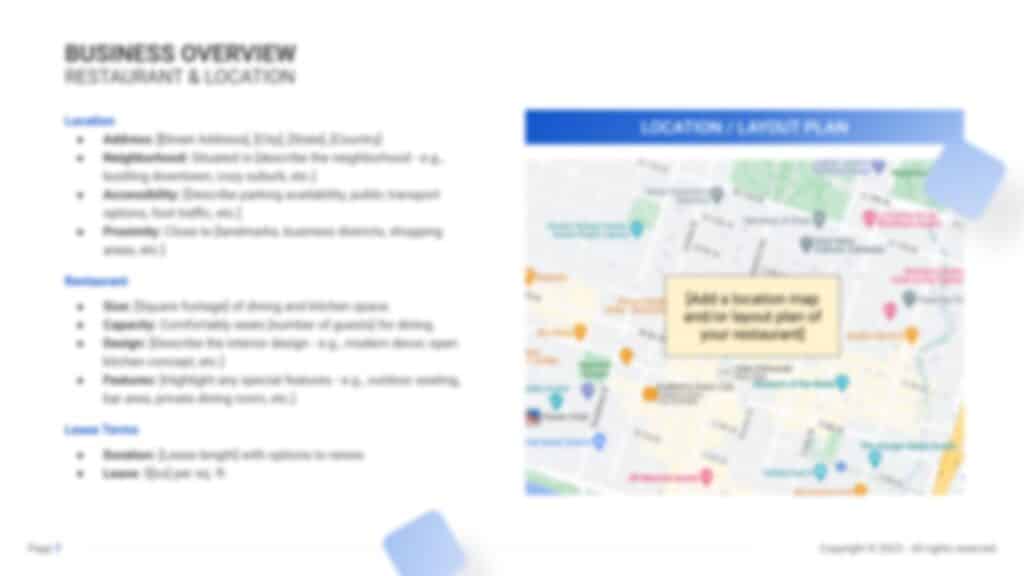
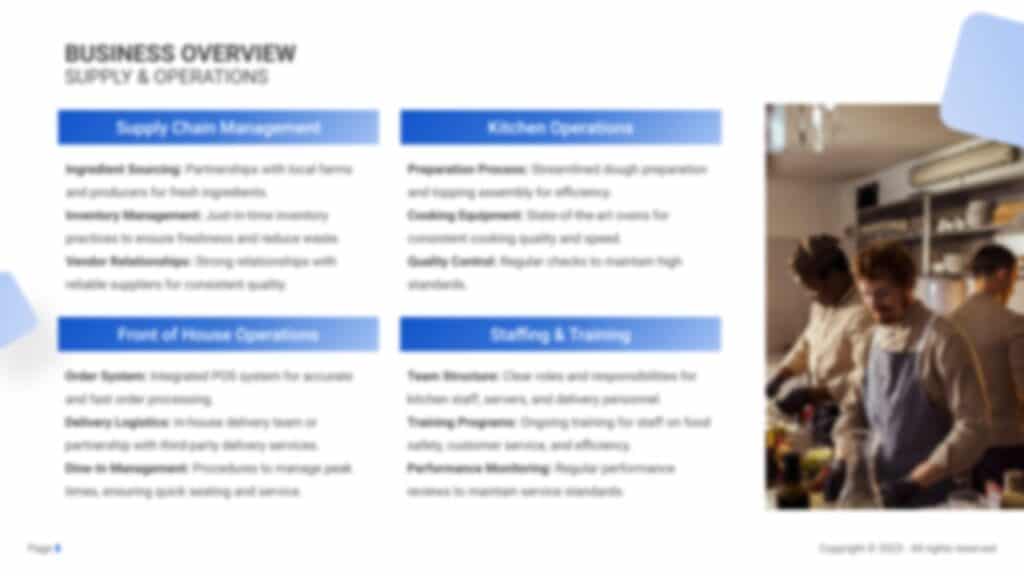
Market Overview
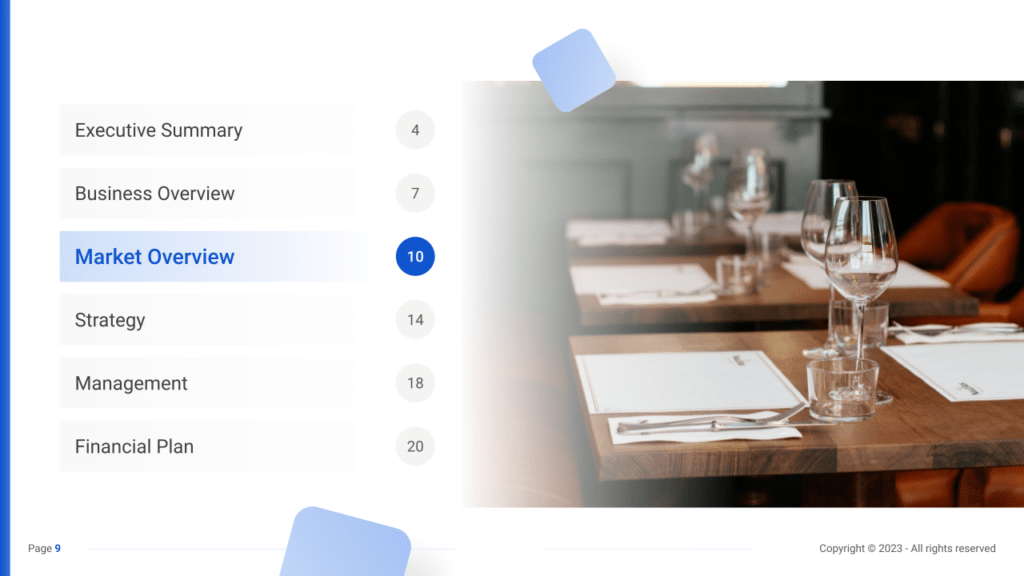
Industry size & growth
In the Market Overview of your restaurant business plan, start by examining the size of the restaurant industry and its growth potential. This analysis is crucial for understanding the market’s scope and identifying expansion opportunities.
Key market trends
Proceed to discuss recent market trends, such as the increasing consumer interest in farm-to-table dining, ethnic cuisines, and experiential dining experiences.
For example, highlight the demand for restaurants that offer unique cultural dishes, the growing popularity of health-conscious and dietary-specific menus, and the integration of technology in enhancing the dining experience.
Competitive Landscape
A competitive analysis is not just a tool for gauging the position of your restaurant in the market and its key competitors; it’s also a fundamental component of your business plan.
This analysis helps in identifying your restaurant’s unique selling points, essential for differentiating your business in a competitive market.
In addition, competitive analysis is integral in laying a solid foundation for your business plan. By examining various operational aspects of your competitors, you gain valuable information that ensures your business plan is robust, informed, and tailored to succeed in the current market environment.
Identifying Competitors in the Restaurant Industry
To comprehensively understand the competitive landscape, start by identifying both direct and indirect competitors in your area. Direct competitors are restaurants offering similar cuisines or targeting a comparable customer base. For instance, if your restaurant specializes in authentic Mexican cuisine, other nearby Mexican restaurants are direct competitors. Indirect competitors may include food trucks, cafes, or even fast-casual eateries offering diverse menus that overlap with your offerings.
Leverage digital tools like Google Maps, Yelp, or food delivery apps to map out the locations of your competitors. Reviews and ratings on platforms like TripAdvisor and social media can offer valuable insights into competitors’ strengths and weaknesses. Positive reviews highlighting exceptional service or a unique dining experience at a competitor’s restaurant can signify an area of focus for differentiation and improvement.

Restaurant Competitors’ Strategies
To conduct a comprehensive analysis, delve into various aspects of your competitors’ operations:
- Menu Offerings: Assess the breadth and uniqueness of dishes offered by competitors. Take note if any local restaurants are gaining traction by focusing on farm-to-table ingredients, regional specialties, or offering innovative fusion cuisines, as these aspects often indicate emerging market trends.
- Service and Ambiance: Evaluate the overall customer experience. Identify if there’s a competitor renowned for its fine dining experience, another known for its trendy and vibrant atmosphere, or one that excels in providing a casual, family-friendly environment. These elements significantly contribute to a restaurant’s success and differentiation.
- Pricing and Positioning: Compare pricing strategies. Determine whether competitors are positioned as budget-friendly eateries or if they adopt a more upscale approach with premium pricing, highlighting gourmet ingredients, or exclusive dining experiences.
- Marketing Channels: Analyze how competitors market their restaurants. Do they leverage social media platforms for promotions, engage in collaborations with local influencers, or host special events or themed nights? Understanding their marketing tactics provides insights into effective promotional strategies that resonate with the target audience.
- Operational Efficiency: Observe if competitors have adopted technological advancements such as online reservations, mobile apps for ordering, or contactless payment systems. These innovations not only streamline operations but also contribute to an enhanced customer experience.
What’s Your Restaurant’s Value Proposition?
Reflect on what uniquely distinguishes your restaurant from the competition. It could be your innovative fusion of cuisines, a strong emphasis on locally sourced and sustainable ingredients, or perhaps a distinctive ambiance that reflects a particular cultural theme or historical narrative.
Listen attentively to customer feedback and observe emerging industry trends to identify gaps or unmet demands in the market. For instance, if there’s a growing interest in plant-based dining experiences and competitors have not tapped into this niche, it could present an opportunity for your restaurant to cater to this demand and stand out.
Consider how your restaurant’s location influences your strategy. A downtown location might warrant a focus on quick service and catering to office lunch crowds, while a suburban setting could embrace a more relaxed, family-friendly dining environment.
Strategy
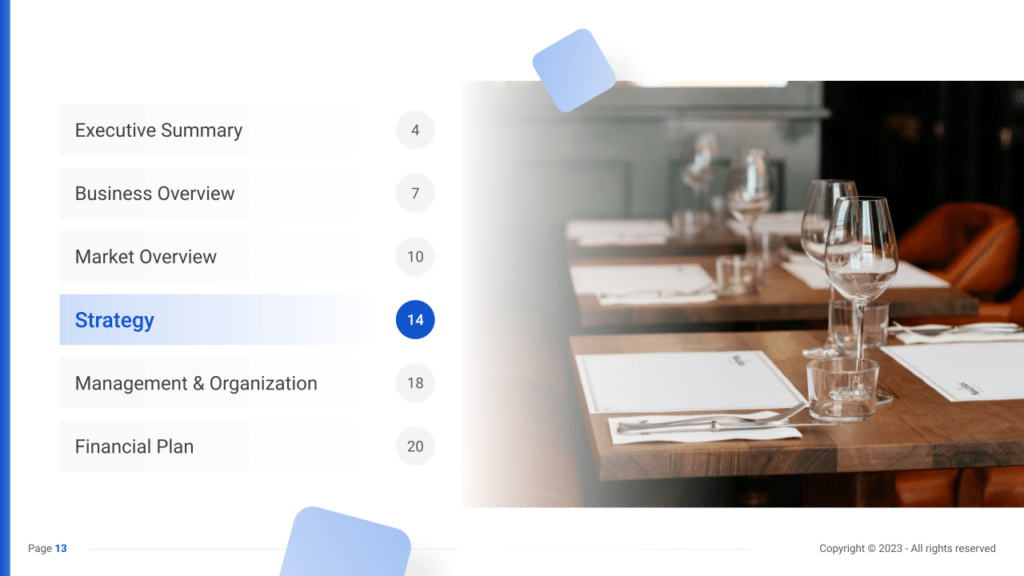
SWOT
First, conduct a SWOT analysis for the restaurant, highlighting Strengths (such as a unique menu and exceptional customer service), Weaknesses (including potential high operational costs or strong competition in the area), Opportunities (for example, a growing interest in diverse cuisines and healthy eating), and Threats (such as economic downturns that may decrease consumer spending on dining out).

Marketing Plan
Next, develop a marketing strategy that outlines how to attract and retain customers through targeted advertising, promotional discounts, an engaging social media presence, food blogger outreach, and community involvement, such as local events or charity sponsorships.
Marketing Channels
Utilize various marketing channels to engage with your audience and attract new patrons.
Digital Marketing
- Social Media: Utilize social media platforms such as Instagram, Facebook, Twitter, and TikTok to showcase your restaurant’s ambiance, signature dishes, behind-the-scenes glimpses, chef profiles, and customer testimonials. Regularly engage with your audience by responding to comments, hosting interactive polls, or sharing user-generated content.
- Email Marketing: Implement an email marketing strategy to build a loyal customer base. Offer incentives such as exclusive recipes, promotional offers, or early access to special events in exchange for subscribing to your newsletter. Regularly communicate with your subscribers, sharing updates, promotions, and stories that resonate with your brand.
- Website and SEO: Maintain an informative website showcasing your menu, chef profiles, reservation options, and reviews. Optimize it for local SEO to ensure visibility in searches related to your cuisine and location.
Local Advertising
- Printed Materials: Distribute well-designed flyers in nearby neighborhoods, advertise in local magazines, and collaborate with tourism centers or hotels for exposure.
- Community Engagement: Sponsor local events, collaborate with food bloggers or influencers, and participate in food festivals or charity events to increase brand visibility and community involvement.
- Partnerships: Forge partnerships with complementary businesses (such as wine shops or local farmers’ markets) for cross-promotions or collaborative events.
Promotional Activities
Engage potential customers through enticing offers and events.
- Special Offers: Launch promotions like ‘Chef’s Tasting Menu Nights’ or ‘Happy Hour Discounts’ to attract new diners and retain regulars.
- Loyalty Programs: Implement a loyalty system offering rewards for frequent visits or referrals, such as a free appetizer or dessert after a certain number of visits.
- Events and Special Occasions: Host themed nights, seasonal menus, or exclusive culinary events to create buzz and attract diverse audiences.

Sales Channels
Efficiently manage sales channels to maximize revenue and customer satisfaction.
In-Restaurant Upselling
- Menu Strategies: Highlight premium dishes or chef’s specials, offer wine pairings or dessert suggestions, and train staff to upsell without being pushy.
- Merchandising: Display branded merchandise, specialty sauces, or cookbooks for sale to complement the dining experience.
Online Ordering and Delivery
- Online Ordering Platform: Implement an easy-to-use online ordering system for takeout or delivery orders. Offer exclusive online discounts or bundle deals.
- Delivery Partnerships: Collaborate with food delivery services or establish in-house delivery for customers’ convenience.
Reservation Management
- Reservation System: Utilize an efficient reservation platform to manage bookings. Offer incentives for off-peak reservations or special occasions.
Membership and VIP Programs
Developing membership and VIP programs can cultivate a loyal customer base and drive recurring revenue:
- VIP Memberships: Create exclusive membership tiers offering perks like priority reservations, chef’s table access, or private event invitations.
- Reward Programs: Develop a digital loyalty system where customers earn points for every dollar spent, redeemable for discounts, exclusive menu items, or special events.
Strategy Timeline
Finally, create a detailed timeline that outlines critical milestones for the restaurant’s opening, marketing campaigns, customer base growth, and expansion objectives, ensuring the business moves forward with clear direction and purpose.

Management
The management section focuses on the restaurant’s management and their direct roles in daily operations and strategic direction. This part is crucial for understanding who is responsible for making key decisions and driving the restaurant towards its financial and operational goals.
For your restaurant business plan, list the core team members, their specific responsibilities, and how their expertise supports the business.
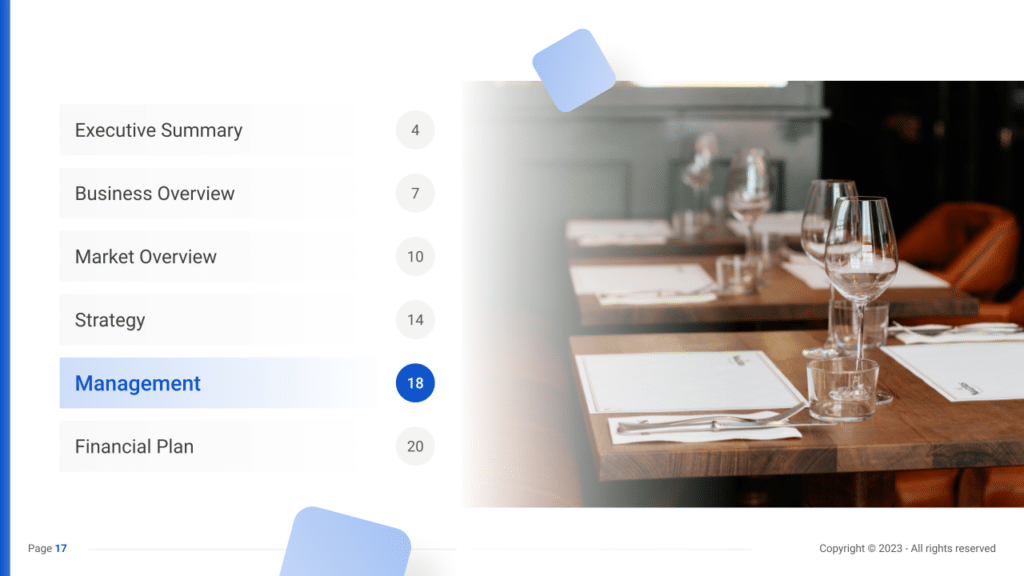

Financial Plan
The Financial Plan section is a comprehensive analysis of your financial projections for revenue, expenses, and profitability. It lays out your restaurant’s approach to securing funding, managing cash flow, and achieving breakeven.
This section typically includes detailed forecasts for the first 5 years of operation, highlighting expected revenue, operating costs and capital expenditures.
For your restaurant business plan, provide a snapshot of your financial statement (profit and loss, balance sheet, cash flow statement), as well as your key assumptions (e.g. number of customers and prices, expenses, etc.).
Make sure to cover here
_ Profit and Loss
_ Cash Flow Statement
_ Balance Sheet
_ Use of Funds
